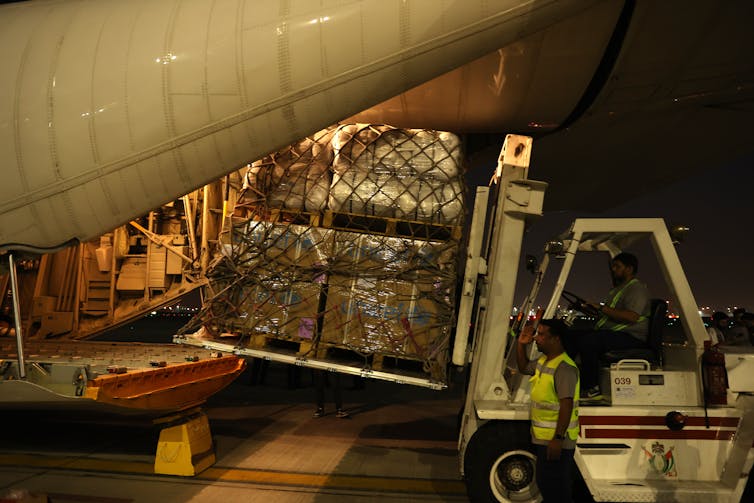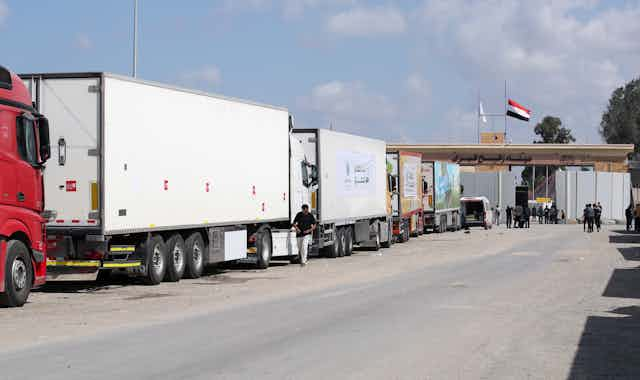The population of the Gaza Strip remains cut off from basic supplies like water, food, and electricity since Israel’s defence minister, Yoav Gallant, ordered a “complete siege”. No aid has been able to reach Gaza and the first promised convoy has just been delayed further.
While sieges are not illegal under international humanitarian law, there are rules prohibiting the starvation of civilians and regulating humanitarian relief operations.
Transporting humanitarian relief into besieged territories is a complex challenge, but such relief is essential to minimise human death and suffering. During the siege of Sarajevo in the 1990s, 160,000 tons of aid were delivered in more than 12,000 flights. But the population of Gaza is much larger and meeting their needs will be far more challenging.
Israel is massing its forces at the borders of Gaza in apparent preparation for what it says will be a ground assault to eliminate Hamas as a political and military force. Yet the vast majority of people in Gaza are not militants and have a human right to food, water and fuel.
Even before the latest escalation, 80% of the 2.2 million people living in Gaza were in need of humanitarian assistance. A fortnight of airstrikes and the state of siege imposed by Israel has exacerbated this situation. The UN secretary general, António Guterres, has called for “immediate unrestricted access of humanitarian aid to respond to the most basic needs of the people of Gaza”.
Limited options
At the centre of the demands for humanitarian access is the Rafah border crossing between Egypt and Gaza. It is the only way to enter Gaza without going through Israel.
While humanitarian logistics uses all modes of transport, options are limited in this situation. Humanitarian aid by sea used to arrive mainly through the Port of Ashdod, which is in Israel. Gaza has a small fishing port, but this is completely unsuitable for larger deliveries.
Using aircraft to deliver supplies in an operation similar to the Berlin airlift of 1948-49 might seem appropriate for a besieged territory. But this is impossible because of a lack of airfields in Gaza. The EU humanitarian air bridge to Gaza flies into Al-Arish airport in Egypt.
As there is no safe airspace, dropping aid from planes is also not possible. Humanitarian air drops are generally an option of last resort because of their low capacity, high cost, and operational hazards.
The US president, Joe Biden, has announced an agreement with Egypt to let up to 20 trucks of humanitarian assistance through the Rafah crossing. These would be the first deliveries of life-saving supplies into Gaza since the start of the siege.

Deliveries were intended to begin on Friday October 20, but the plans have now been delayed by at least a day. In any case, with the sole option of supplying Gaza by road, 20 trucks are “a drop in the ocean of need”, according to WHO’s emergencies chief Mike Ryan.
The World Food Programme alone has stockpiled 310 tons of supplies in Egypt, which it estimates could feed 244,000 people for a week. According to Martin Griffiths, under-secretary general for humanitarian affairs with the UN, 100 trucks a day are necessary to meet needs across Gaza.
Even though humanitarian supplies are unable to reach Gaza, organisations have been moving them as close as possible to the Rafah crossing. Known as “pre-positioning”, this practice allows for a quicker response.
More than 3,000 tons of supplies are awaiting onward distribution on the Egyptian side of the border. These include anything from fortified biscuits to medical trauma kits. Under UN flags and with international observers inspecting the cargo, it is hoped that aid can start flowing across the border soon.
Dangerous and difficult
But once inside Gaza, its progress will be impeded by the sustained air attacks. Much of the population of Gaza will be difficult to reach as a result as they seek shelter from the bombing. Israeli military operations endanger the lives of humanitarian personnel distributing aid and, despite their urgent needs, it remains dangerous for people to leave their shelter to collect vital supplies.
While the wellbeing of civilians takes priority according to humanitarian principles, it is hard to separate civilian needs in Gaza from politics and armed resistance. Israel is threatening to stop all humanitarian access if any aid reaches Hamas.

While some items such as infant formula are likely to only be useful for civilians, there is more debate about others, such as fuel. Essential for water desalination or power generators at hospitals, fuel is a life-saving supply. However, Israel is reluctant to permit its distribution as aid for fear of fuel deliveries helping Hamas.
Using local suppliers is an important strategy in humanitarian logistics. Localisation has many benefits – including empowering the local economy. Increasingly, humanitarian assistance does not consist of handing out goods brought in from abroad.
Instead, agencies increasingly use cash and vouchers to allow people to make their own purchasing decisions. But there needs to be a functioning market in place for this approach to be suitable. This cannot be assumed in Gaza at present.
Ensuring a supply of fuel and clean water could also help businesses within Gaza to play a role in meeting the needs of the local population. The World Food Programme has continued to work with local bakeries to provide fresh bread to displaced people.
But with each day, more bakeries have to stop production because of a lack of fuel and ingredients and available supplies cannot be distributed because of destroyed infrastructure.
International support is needed to manage the complex logistics. The Egyptian Red Crescent and UN agencies need to play leading roles in coordinating the preparations for aid deliveries, combining regional and international logistics expertise.
But first a ceasefire must be achieved to allow unimpeded access to all those in need and so ensure the safety of those engaged in humanitarian operations. A first United Nations Security Council resolution that would have called for humanitarian pauses was vetoed by the US.

